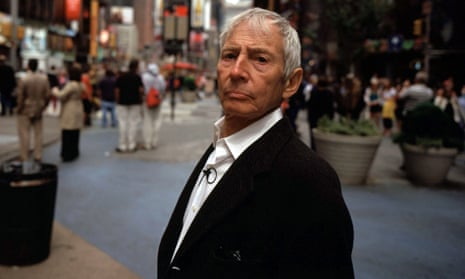I’m up to Burma in The World at War, the landmark 26-part account of the second world war made in the mid-70s and recently repeated on BBC2. It reminds us how documentaries used to be done: record witness testimony, intersperse it with archive footage where available, and hire a theatrical knight of the realm to fruitily over-pronounce the foreign names.
Not any more. The modern documentary is closer in execution to high-end drama. A case in point is HBO’s The Jinx: The Life and Deaths of Robert Durst (Thursday, 9pm, Sky Atlantic), an addictive true detective story told in six hour-long parts and whose firsthand affidavits, court recordings and microfiche headlines are enhanced by dramatic reconstruction so hard-boiled you could be watching a Coen Brothers movie. It examines, in literal forensic detail, the case of Robert Durst, the urbane multimillion-dollar heir to a Manhattan property fortune accused and acquitted of dismembering and bagging up a neighbour in Galveston, Texas, in 2001, and still believed to know more than he lets on about the 1982 disappearance of his first wife. On arrest, Durst jumped bail, igniting a nationwide manhunt, which ended when he was caught shoplifting a chicken sandwich in Bethlehem, Pennsylvania, despite having $38,000 cash in his glove box (plus a bag of marijuana and two pistols). You couldn’t make it up.
The Jinx was directed by Andrew Jarecki, who made Oscar-nominated documentary Capturing the Friedmans, about a child molestation case, and, more pertinently, All Good Things, a repellent Ryan Gosling/Kirsten Dunst thriller fictionalising Durst’s life story, which Durst was pretty much alone in giving the thumbs-up to. This landed Jarecki a long sit-down interview with the desiccated, immaculately dressed 71-year-old sociopath which would go on to form the centrepiece of The Jinx. Creepily compelling and yes-sir-no-sir courteous, Durst is reason enough to watch, but Jarecki uses every trick in the dramatist’s book to keep us glued: the pre-credits “cold open”, the ad-break tease, languorous tracking shots, copious slo-mo – even the credits sequence is close to True Detective, with cinematic vignettes dissolving over a suitably gothic Eels tune. It’s all elegantly done, but – as with the dreamlike image of Durst’s mother falling to her death from the roof in her nightie when he was seven – it editorialises as it illustrates.
All six episodes have been made available online by Sky in one Netflix-style hit, but I haven’t reached the final revelation yet, which I understand is a jaw-dropper. I do know that “key new evidence” from the series has put Durst back in the orange jumpsuit for the “execution-style” murder of a mobster’s daughter 15 years ago. He was arrested the day before the last episode of The Jinx aired in the States; one assumes the HBO publicity team were given the day off.
In the first episode, downhome detective Gary Jones, who discovered a torso in Galveston Bay, recalls having to put his hand down the headless corpse’s throat to grab the breastbone in order to fish it out of the water. Jarecki is smart enough to know that God exists in such gory details and withholds information for cliffhanging effect while his camera pans patiently over a tabletop of evidence, casting us as the armchair detectives with a pause button.
You can see why critics have been comparing The Jinx to Serial, the hit podcast which re-examined the 1999 murder of a Baltimore student, gripping millions as it unfolded weekly. Its findings also led to an appeal, blurring the lines between investigative journalism and prurient murder-casebook schlock. The Jinx is similarly habit-forming but, in upping the noirish melodrama, bestows skin-crawly celebrity on a wealthy self-confessed wife-beater and possible murderer. In defence of the modern TV documentary, it thinks it has to work a lot harder to get your attention. So how come I was utterly gripped by the World At War when most of it was in black and white and none of it was in slo-mo?








Comments (…)
Sign in or create your Guardian account to join the discussion